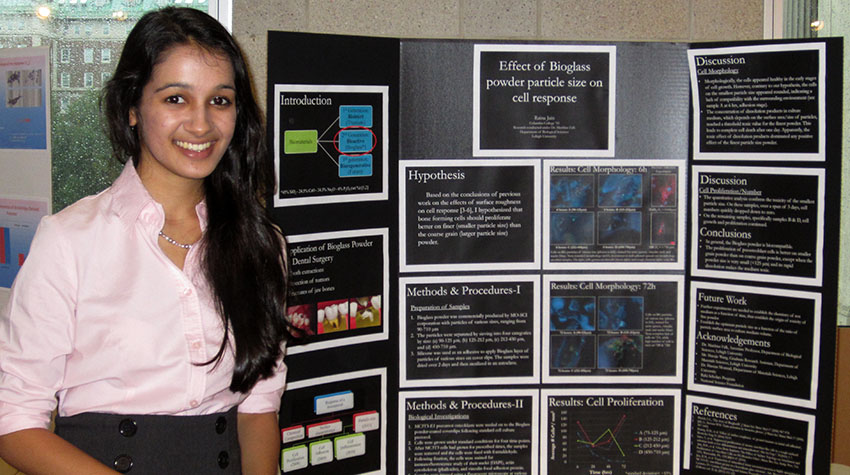Experiencing President Obama’s ‘deep interest and genuine curiosity’ in science

The White House Science Fair, started by President Obama, acknowledges and celebrates young researchers by inviting them to present their STEM pursuits at the White House.
The White House Science Fair shows “tremendous progress for the scientific community, in a society that showers primarily athletes with praise,” said Raina Jain, who attended the first fair in 2010.
Every year, several Society alumni have been chosen to participate in the fair. Raina was a 2011 Intel STS semifinalist.
She believes parents and teachers have the ability to transform a child’s career — and encourages them to support young scientists and make science more accessible to every child. Read the interview below to find out more about Raina’s science beginnings.
TELL US ABOUT YOUR VISIT TO THE WHITE HOUSE: I felt fortunate and overwhelmed to have been given the opportunity to present my bioengineering research to President Obama at the first official White House Science Fair. In a society that showers primarily athletes with praise, it was tremendous progress for the scientific community when the President acknowledged young research endeavors as equally important.
Transform young people’s lives like Raina. Join the Society today!
I distinctly remember being impressed with President Obama’s deep interest and genuine curiosity about my research on a bioactive glass that has the extraordinary capability to promote bone growth. He was eager to learn how this material could impact those suffering from degenerative bone diseases, such as osteoporosis.
The experience itself was a blur. I was lost in the excitement and anxiety that inevitably accompanies meeting the President. I was so nervous that I left my suit jacket in one of the security checks, which I was told I would never see again — apparently there is no lost and found at the White House.
WHAT ARE YOUR CURRENT SCIENCE GOALS: Since the White House Science Fair, my interest in science developed much further. I’ve gotten different perspectives on research, from the lab bench to policy decisions.
I graduated from Columbia University last May with a bachelor’s degree in biology. Now I’m working at the Memorial Sloan Kettering Cancer Center at the Center for Health Policy and Outcomes.
At the center, I work with Dr. Peter Bach, a leading advocate against the increasingly high prices of cancer drugs. I’ve learned an incredible amount about a different aspect of research, the access of patients to advanced treatments after they have been approved.
I’m applying to medical school and hope to focus on global health/inequalities in access to medicine.
ON THE IMPORTANCE OF GIVING BACK: During college, I continued my research over the summers, working on a range of topics including cancer treatments and epigenetics. I learned a lot through academic and research experiences, all of which confirmed my intention of pursuing a career in medicine.
I was also given several opportunities to share my interests with youth. Throughout college, I was able to return to my middle school and talk to 7th grade students about my own science project and the importance of getting involved in research at a young age. I encouraged them to pursue their own scientific interests, whether it be ecology, physics, biology, or the wealth of subjects which research can encompass.
I returned to my middle school and talked about the importance of getting involved in research at a young age.
In my second year of college, I was invited to speak at the Congress for Future Medical Leaders in Washington, D.C., which hosted 5,000 high school students interested in medical careers. I encouraged students to explore their passion for medicine and health, and met with several individually to discuss how to turn their interests into action.
It was an incredible experience. Seeing the sheer number of youth who were devoted to the sciences was a reminder of the progress society has made in encouraging careers in STEM.
ADVICE TO PARENTS AND TEACHERS WITH CHILDREN SHOWING AN INTEREST IN STEM: I was raised in a family of scientists. My mom was a practicing physician and my dad was an engineering professor.
Parents and teachers have the ability to transform a child’s career. Through the support of my teachers and parents, I was able to consider pursuing research, a hobby which has now turned into my passion, my current job, and my future.
There is a different type of science, one which spans far beyond the textbook, that has the ability to inspire.
I was so fortunate to have the most supportive mentors, from my middle school science teacher who accompanied me to science competitions, to a professor who welcomed a 13-year old into his laboratory with open arms. Without such encouragement, it becomes more difficult, although not impossible, for a child to gain access to resources that can open their eyes to science.
While every student will sit through several science classes, there is a different type of science, one which spans far beyond the textbook, that has the ability to inspire. That science is the one which the White House Science Fair recognized, and the one which needs to be accessible to every child.


